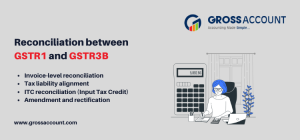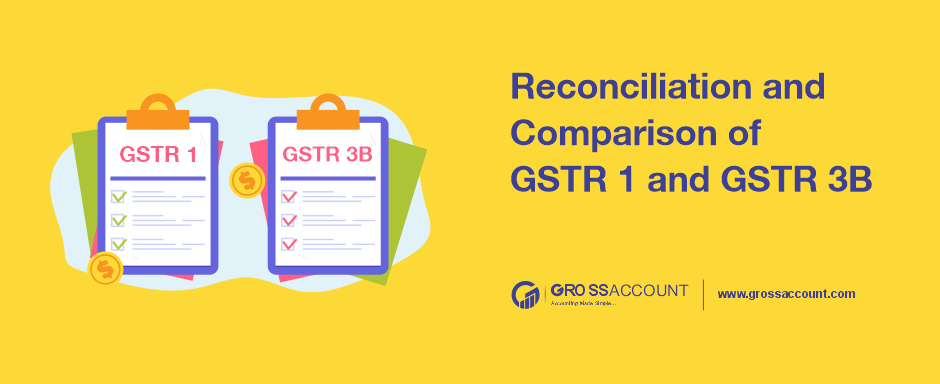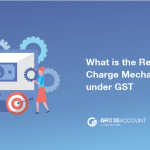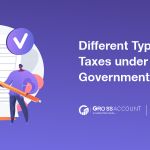Introduction
Reconciliation between GSTR1 and GSTR3B is necessary for any business. If you don’t know what the GSTR1 and GSTR3B are then please continue to the end you’ll find every answer to your question. Just to brief under GST, taxpayers have to pay various returns to ensure compliance. Two important returns are GSTR-1 and GSTR-3B.
Why I said that it is necessary for any business because if any mismatch connection finds between them then it is an impossible task for all businesses to file an accurate annual GST Return due to the mismatches.
In this blog, we will explore what is GSTR 1 and GSTR 3B. Highlighting how it is different from each other. What should happen if anything goes wrong?
Before going to the reconciliation and comparison of GSTR1 and GSTR3B let’s know some basic things about GSTR1 and GSTR3B
What is GSTR1?
GSTR 1 is a monthly/quarterly based return that includes all the sales that happened or were paid by the taxpayers. It includes information on sales, exports, and any other taxable supplies. You must ensure that every detail is accurate while entering the sales invoice.
GSTR 1 Due date
GSTR-1 due dates are based on your aggregate turnover. Under the QRMP scheme, businesses with sales up to RS.5 crore are required to file quarterly returns by the 13th of the month following the relevant quarter.
GSTR 1 late fees
In case of turnover up to Rs 1.5 crore, the late fee is limited to Rs 2,000 per return (i.e. Rs 1000 for CGST and SGST).
What is GSTR3B?
GSTR3B is a monthly basis return summary of tax liability for a particular period. GSTR-3B consolidates the tax liabilities and input tax credit (ITC) available for a given period.
GSTR 3B Due date
The due date for filing GSTR-3B is the 20th of the following month. This due date applies to all registered taxpayers, regardless of their turnover.
GSTR 3B late fees
If you file GSTR-3B after the due date, you will be charged a late fee of Rs. 50 per day and Rs. 20 for the taxpayers with no monthly tax liability.
What types of reconciliation are there in GSTR1?
Invoice-level Reconciliation
This type of reconciliation involves cross-verifying the invoices reported in GSTR-1 with the invoices received from the suppliers. The purpose is to ensure that all the invoices issued by the taxpayer are correctly captured and there are no missing or incorrect invoices.
Tax Liability Reconciliation
This type of reconciliation focuses on ensuring that the tax liability calculated in GSTR-1 aligns with the actual tax payable based on the outward supplies. The objective is to identify any differences or errors in the tax calculations and rectify them.
Reconciliation and Comparison between GSTR1 and GSTR3B
Reconciling GSTR-1 and GSTR-3B is crucial to ensure accurate reporting of outward supplies and tax liability. Let’s explore the key aspects of reconciliation and comparison between these returns:

Invoice-level reconciliation
Taxpayers should reconcile the invoices reported in GSTR-1 with those considered for the outward supplies summary in GSTR-3B. Any inconsistency between these, such as missing or incorrect invoices, should be identified and rectified to avoid any potential compliance issues.
Tax liability alignment
The Tax liability calculated in GSTR-3B should match the tax payable on outward supplies reported in GSTR-1.
ITC reconciliation (Input Tax Credit)
Taxpayers need to reconcile the ITC claimed in GSTR-3B with the eligible ITC based on invoices uploaded by their suppliers in their GSTR-1.
Differences between the ITC claimed and the eligible ITC can arise due to various reasons, such as invoices not being uploaded by suppliers, errors in data entry, or mismatched tax rates.
Amendment and rectification
If any errors occur in GSTR-1 or GSTR-3B, taxpayers have the provisions to amend their returns(or you can say update their returns). But it should be followed by the prescribed guidelines and timeframes to avoid penalties and to maintain compliance.
The Significance of Reconciliation
The reconciliation and comparison of GSTR-1 and GSTR-3B offer several benefits to taxpayers and the tax administration:
Accuracy in Reporting
By reconciling and aligning the data reported in GSTR-1 and GSTR-3B, It reduces the chances of errors, omissions, or inconsistencies in reporting outward supplies and tax liabilities.
Compliance and avoidance of penalties
Reconciliation helps taxpayers identify and rectify any glitch(difference) between the two returns, ensuring stick to the GST regulations. By avoiding penalties and interest charges, taxpayers can maintain a good compliance record.
Seamless utilization of ITC
Reconciliation ensures that the ITC claimed in GSTR-3B matches the eligible ITC based on the invoices uploaded by suppliers in GSTR-1. This enables taxpayers to effectively utilize the available ITC, reducing their tax burden and promoting seamless business operations.
Enhanced transparency and accountability
Reconciliation promotes transparency and accountability in the GST system. It enables tax authorities to cross-verify the reported data, identify potential tax evasion, and conduct effective audits if required.
Best Practices for Reconciliation
To ensure a smooth and accurate reconciliation process, taxpayers should consider the following best practices:
Regular monitoring
Taxpayers should monitor and reconcile their GSTR-1 and GSTR-3B returns regularly, preferably every month. This helps in identifying discrepancies and rectifying them promptly.
Timely rectification
Any errors identified during reconciliation should be rectified on time. Sticking to the prescribed timelines for amendment or rectification ensures compliance and minimizes penalties.
Robust accounting and record-keeping
Maintaining accurate and up-to-date accounting records, invoices, and supporting documentation is essential for reconciliation. It facilitates easy identification and rectification of discrepancies.
Automation and technology
Taxpayers can leverage automation and technology solutions to streamline the reconciliation process. GST Software or accounting platforms that integrate GSTR-1 and GSTR-3B can help in identifying discrepancies and ensuring accurate reporting.
Conclusion
Reconciliation and comparison can play a pivotal role in ensuring accurate tax compliance under the GST regime. By aligning the data reported in both returns, taxpayers can avoid penalties, maintain compliance, and utilize the available ITC efficiently.
Automate your accounting work related to GST with GrossAccount’s GST Accounting Software. Software is customizable according to customer needs with features like GST Compliant Invoices, GST Auto Calculation, Generate Intelligent Reports, and Purchase and sales management with more.
FAQs
1) Can we file GSTR1 without filing GSTR3B?
No, GSTR1 can not be filled if the previous GSTR3B was remaining to fill.
2) What happens if the invoice is missed in GSTR1?
If an invoice is missed in GSTR-1, it can result in non-reporting of the transaction, leading to incorrect tax liability calculation and non-compliance with GST regulations.






